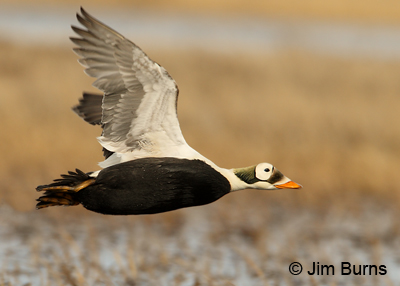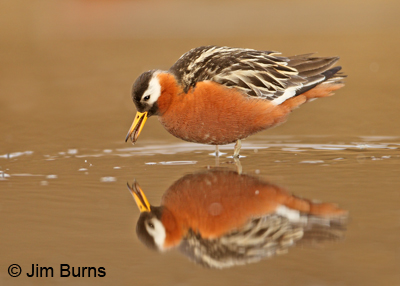
If, in the history of popular music, there is a song with more ungrammatical and nonsensical lyrics than America’s “A Horse With No Name” (1972), I can’t readily recall it. Nonetheless, one line of the song contains an elegant analogy—“The ocean is a desert with its life underground”—which always floats through my head whenever we bird The Arctic. Substitute “tundra” for “ocean” in that line and you have, not an analogy, but a fact. Barrow averages 4.5 inches of rain and 28.7 inches of snow per year. It’s cloudy and 28º as we drive out across the tundra, barren and treeless, but an amazing transformation has already begun.
Observing this transformation is just one of several reasons why birders endure sleepless nights, prevailing winds off the pack ice, and humping over soggy hammocks to bird the tundra out of Barrow. Here are three others: the possibility of seeing well the uncommon eiders and loons; the probability of seeing well, in their alternate, nuptial plumage, a handful of shorebirds seen only in their drab, winter plumage in the lower forty-eight; a chance to assuage, if only for a moment, that longing buried deep within the human soul for the way things were before nature was overridden by society.
The second week of June is “melt week.” There are only three roads out of Barrow, none paved, all now lined intermittently with four to ten feet of dirty snow. The snow plows have been at work. Now it’s the sun’s turn. Sunlight is sunlight, even at 28º, and this desert is burgeoning from beneath as the top layer of permafrost melts. We clamber into our chest waders, leave the road, and are immediately immersed in a wet, miniature world of emergent vegetation and insect life: lichen, moss, dwarf willow, yellow poppy, mites, springtails, mosquito larva, caterpillars, bees, voles, lemmings.
The loons, shorebirds and a few passerines are arriving from the south, the eiders from the west and north where they have spent the winter in holes in the sea ice. They have thirty to sixty days to establish territories, mate, raise young, and get out of Dodge. The Barrow Christmas Count often records only one species, Common Raven. The avian pace is frenetic, our highlights unbelievable. The best is the two pair of Steller’s Eiders squabbling over a pond right in front of us as a flock of 17(!) Spectacled Eiders, birders’ “spectacular” eider, flies by—two of North America’s rarest regular breeding birds, both on the endangered species list and both proscribed even for native subsistence hunting, seen well and simultaneously!
Sunday, June 19, 2011, Barrow, AK, 11:00am—As we cross the tarmac to our awaiting plane, it is 50º in a cloudless sky. There is not a patch of snow anywhere. We have photographed 28 species, not great quantity for ten days, but awesome quality—Pacific and Red-throated Loons, all three eiders, Pectoral Sandpipers with their black throat sacs inflated, Gray-tailed Tattler, female Red Phalarope in all her nuptial plumage glory, Hoary Redpoll. We have found the nests of 13 species including King Eider, Dunlin, Snowy Owl, Pomarine Jaeger, Arctic Tern, and Snow Bunting. We are exhausted, as much by avian sensory overload as by the pace of our 4am-to-10pm-with-an-afternoon-nap birding schedule.
You will NOT experience the tundra as we did if you go as a participant on a birding tour. You MAY experience it as we did if you go on your own and get an off-road hiking permit ($150 from the native Inupiat corporation). You WILL experience it as we did if you go on a Matthew Studebaker photography tour (studebakerbirds.com). Matthew is arguably North America’s best bird photographer. He is inarguably the best leader and one of the best human beings with whom we’ve had the privilege of touring. If you’re not a bird photographer (yet), buy a camera and fake it. It’s one of those trips of a lifetime.
